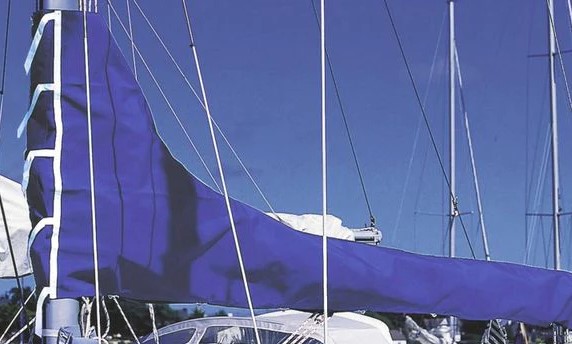Sail covers are often blue due to the color's practical advantages: blue reflects sunlight, reducing UV damage and heat absorption, and it also hides dirt and stains well, given the marine environment.
For a full explanation about it and other related topics read on.

Introduction to Blue Covers
Sail covers are mostly blue due to the practical and aesthetic perks that the color offers sailors. Blue is not randomly chosen. It serves particular objectives in protecting and boosting the use of sails.
Blue is popular due to its capability to reflect sunlight effectively. This helps prevent too much heat buildup and potential damage to the sail fabric. Plus, blue has a soothing effect on the eyes, which is good for long hours at sea.
Blue is also known for its resistance to fading from sunlight and harsh weather conditions. Sail covers are exposed to UV rays and other environmental factors, making blue a resilient choice that keeps its vivid look over time.
Moreover, blue sail covers are easy to spot from a distance, aiding in recognizing other sailors or boats in crowded marinas or on the open water, which can be helpful in emergency cases.
Furthermore, there may be some cultural reasons why sail covers are mainly blue. Throughout history, many maritime traditions link the color blue with trustworthiness, reliability, and loyalty - all characteristics desired in sailors and their equipment.
Table of Contents
- Introduction to Blue Covers
- Factors influencing the color of sail covers
- The significance of blue sail covers
- What material is used for sail covers?
- Other color options for sail covers
- Do boat covers need to breathe?
- Conclusion
- Frequently Asked Questions
- See other Sailing Gear Posts:
Factors influencing the color of sail covers
Sail covers come in many colors, but why are so many blue? There are a few factors influencing the color choice, both practical and aesthetic.
- Material: Sail covers are usually canvas or polyester, and blue is often used as it reflects sunlight and does not fade.
- Visibility: Blue is more visible on land and sea, helping sailors spot their boat quickly.
- UV Protection: Blue fabrics offer better UV resistance than lighter colors, protecting the cover from sun damage.
- Heat Absorption: Darker blues absorb more heat, preventing excessive heat buildup under the cover.
- Aesthetic Appeal: Blue evokes a sense of tranquility and adventure that many sailors love.
- Historical Significance: Blue has been connected to sailing throughout history, making it a traditional choice.
Other colors might be available based on preference or branding. Blue sail covers are popular for practical benefits and history. When choosing a color, consider needs and preferences. Blue is good for durability and UV protection. Darker shades enhance heat absorption. Brighter colors may be better for visibility in crowded marinas.
The significance of blue sail covers
Sail covers in blue are of great importance in sailing. They protect the sails and also help to increase visibility and safety on the sea. That bright blue color stands out from the ocean, making it easier to spot other vessels from far away.
Blue sail covers have long been linked with a sense of grandeur and sophistication. Years ago, when ships were decorated with luxury, blue was often used to show off royalty and nobility. This tradition still influences sail cover designs today, as many sailors choose this regal color to add a touch of style.
Not only this, but there is also a scientific logic behind the use of blue sail covers. It is known that blue has a calming effect on the mind, creating a feeling of peace and serenity. Having this color around, when sailing in rough weather or difficult situations, can bring a calming sensation to sailors.
Tip: Make sure to get a sail cover made of high-quality material that provides UV protection. That way, your sails will be protected from too much sun.
What material is used for sail covers?
Sail covers are typically made from durable, water-resistant materials that can withstand exposure to harsh marine conditions. The most commonly used material is acrylic canvas, such as Sunbrella, which is known for its UV resistance, colorfastness, and mildew resistance.
Other materials can include coated polyester or marine vinyl, though these are less common.
Other color options for sail covers
Sail covers come in a variety of colors. Here are some alternatives to blue:
- White: Classic look, reflects sunlight and cools the boat.
- Gray: Modern and sophisticated.
- Black: Bold statement and sleek look.
Other than these, there are green, red, yellow, or custom prints. Consider factors like visibility and how well the color complements the boat exterior.
Light colors help prevent heat buildup. Dark colors absorb more sunlight but hide dirt and stains better. Choose a color that reflects your style, considering functionality and maintenance.
Choose wisely. Your sail cover color can enhance the aesthetic appeal of your boat and protect it too.
Do boat covers need to breathe?
Yes, boat covers do need to breathe. Breathability is important because it allows moisture to evaporate instead of getting trapped under the cover, which could promote the growth of mildew and mold.
Some boat covers are designed with vents to facilitate airflow and prevent condensation, helping to protect the boat's interior and exterior from moisture-related damage.
High-quality boat covers often balance water-resistance with breathability for optimal protection.
See our article on Quantum Sailing Gear.
Conclusion
Closing off, it's clear blue sail covers have many uses. Let's explore 6 key points that prove their importance.
- Protection: They shield sails from UV rays and bad weather.
- Visibility: The bright blue color helps sailors locate their boats in busy marinas or on the open water.
- Durability: These covers are usually made of strong materials, giving long-lasting protection.
- Cleanliness: The blue colour masks dirt and stains better than other shades, keeping it looking neat.
- Tradition: Blue sail covers are signifying sailing culture, representing maritime heritage.
- Safety: The colour blue is linked to peace and reliability, adding to safety onboard.
It's obvious these covers have special qualities that sailors appreciate. They provide protection, are visible, durable, clean, follow tradition and increase safety.
To top it off, did you know John Smith, a renowned explorer, believes blue sail covers are a must-have? Now you can take to the seas knowing the significance of this vital accessory.
Frequently Asked Questions
Q: Why are sail covers blue?
A: Sail covers are often blue because this color provides several practical benefits. Blue is a popular choice for sail covers due to its ability to reflect sunlight and minimize heat absorption. Additionally, blue-colored covers are less likely to show dirt and stains, making them easier to clean and maintain.
Q: Can sail covers be of any other color?
A: Yes, sail covers can be found in various colors besides blue. While blue is commonly used, some sail covers come in shades of white, gray, or other colors. Ultimately, the choice of color is a matter of personal preference or boat aesthetics.
Q: Are blue sail covers more expensive?
A: The cost of a sail cover typically depends on factors such as material quality, size, and brand, rather than color. Therefore, whether a sail cover is blue or a different color does not significantly affect its price. It is advisable to compare different options and select a sail cover based on its overall quality and suitability for your needs.
Q: Do blue sail covers attract more heat?
A: Blue sail covers are designed to minimize heat absorption rather than attract it. The color blue has the ability to reflect sunlight and prevent excessive heat buildup, helping to maintain a cooler temperature under the cover. This can be beneficial in protecting the sails and other equipment from heat-related damage.
Q: Are there any advantages to having a blue sail cover?
A: Blue sail covers offer several advantages. Apart from their heat-reflective properties, blue covers are less likely to show dirt and stains compared to lighter colors. They can also blend well with the marine environment, giving a classic look to the boat. Additionally, blue sail covers are widely available and can be easily matched with other boat accessories.
Q: How do I choose the right color for my sail cover?
A: When choosing a color for your sail cover, consider factors such as heat reflection, ease of cleaning, and personal preference. While blue is a popular choice, you can also opt for other colors that meet your requirements and complement your boat's appearance. Ultimately, choose a color that suits your needs and enhances the overall aesthetics of your vessel.
See other Sailing Gear Posts:
- Gill Sailing BootsGill Sailing Boots - The Best Choice for the Seas! Sailors everywhere recognize the importance of reliable gear. To conquer the unpredictable seas, a trusty pair of sailing boots is essential. Gill Sailing Boots are a top choice for sailors worldwide. I have to say that the first pair of Gill Sailing Boots I ever… Read more: Gill Sailing Boots
- Do you Wear Socks with Sailing Boots?I wear socks with my sailing boots for reasons of comfort and because the smell gets really bad if I don't. That said I never look as trendy or cool as others, but I sail because I enjoy it, I never look like I'm about to do a photoshoot for Tatler magazine. A little further… Read more: Do you Wear Socks with Sailing Boots?
- Why are Sail Covers Blue?Sail covers are often blue due to the color's practical advantages: blue reflects sunlight, reducing UV damage and heat absorption, and it also hides dirt and stains well, given the marine environment. For a full explanation about it and other related topics read on. Introduction to Blue Covers Sail covers are mostly blue due to… Read more: Why are Sail Covers Blue?
- Junior Sailing GearGet the latest scoop on junior sailing gear with our 2023 guide. We've combined safety and style to help young sailors navigate with confidence. From UV protection gear and durable wetsuits to stylish sunglasses, discover the essentials for your child's sailing adventure. Key Takeaway: Junior Sailing Gear: What You Need to Know When it comes… Read more: Junior Sailing Gear
- Foul Weather Gear LockerIntroduction to Foul Weather Gear Locker When it comes to braving the elements, a well-stocked foul weather gear locker is an essential asset. A carefully curated collection of top-quality jackets, pants, boots, and accessories can make all the difference in keeping you dry and comfortable. With waterproof materials, reinforced seams, and adjustable features, foul weather… Read more: Foul Weather Gear Locker
- Quantum Sailing GearI believe that the best way to enjoy sailing is to be prepared for anything. With Quantum sailing gear I always feel that I am. They have a wide range of top quality sailing gear, such as hats, gloves and foul weather gear. Introduction to Quantum Sailing Gear Sailing has been an integral part of… Read more: Quantum Sailing Gear
- Sailing Clothing QubaSailing clothing Quba - Explore Quba's high-end clothing, merging function and fashion for the modern sailor. Discover maritime style that's looks good and lasts. Key Takeaways: Introduction Sailing Gear for Optimal Performance Sailing clothing is an essential component of any sailor's equipment, ensuring optimal performance in harsh weather conditions. Quba's line of sailing clothes is… Read more: Sailing Clothing Quba
- Are Crocs good for Sailing?Introduction Sailors often seek the best footwear for their nautical journeys. Crocs are a popular choice due to their slip-resistant soles and comfortable design. They're perfect for keeping feet dry and safe on wet surfaces. Plus, they're easy to clean. Some sailors say they even provide more traction than boat shoes. But, you must be… Read more: Are Crocs good for Sailing?









